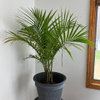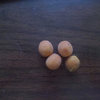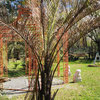I have a potted sago palm that I bought about two months ago. This is my first plant ever-- I am completely new to gardening. It sits by my office window, getting afternoon sun, and is in a comfortable temperature all the time. Right after I bought it, I repotted it in a pot 2" diameter bigger than the pot in came in. I water it every 1.5-2 weeks or so and let the soil dry completely before the next drink.
About a month ago, certain fronds starting getting some yellow spots, which would gradually turn tan and dead (dried-out looking). Eventually, some fronds would die at the ends and the tan, dried-out part would work its way to the frond's stem. I tried not to panic, since it is clearly not white scale, but after researching online, I thought maybe it was the beginning of frizzle top or a manganese deficiency, so I went to the nursery where I bought my sago to purchase some palm food.
One of the nursery employees was treating a palm with yellow patches similar to what mine looked like, and he recommended an all-purpose food. He said he believed it was a fungus and that I should remove all affected fronds.
I came back to my office, gave the plant food to my sago, and then sat down to carefully remove each affected frond. To my horror, I discovered that a great majority of the fronds were affected-- at least with the earliest stage of having some VERY tiny yellow spots, although they looked healthy and the dying out had not started. I cut them off, making my poor sago look totally ragged.
While cutting, I observed that the brownish fuzz I thought was part of the sago's branches was, in fact, something that rubbed off. It is now clear that this brownish, fuzzyish, fluffyish, moldish-type stuff is covering the head of my sago, and then creeping up the branches. Now I am pretty panicked about my new plant! Is this a fungus? The "fuzz" can be rubbed off the branches using a damp cloth, and I have tried gently scraping it off of the head of the sago using the tines of a plastic fork.
Should I be scraping this off of my plant? Buying a fungicide? Is this normal? I have no idea what to think. Please help!










david_
xerophyte NYC
Related Professionals
West Milford Landscape Architects & Landscape Designers · Ashburn Landscape Architects & Landscape Designers · Fort Lee Landscape Architects & Landscape Designers · Marco Island Landscape Architects & Landscape Designers · Roosevelt Landscape Architects & Landscape Designers · Milford Landscape Contractors · Chelmsford Landscape Contractors · Ridgewood Landscape Contractors · River Ridge Landscape Contractors · Rosemount Landscape Contractors · Seminole Landscape Contractors · West Orange Landscape Contractors · Atlantic Beach Window Contractors · Rio Linda Window Contractors · Webster Groves Window ContractorsbiscuitsOriginal Author
david_
xerophyte NYC
david_
biscuitsOriginal Author
xerophyte NYC
biscuitsOriginal Author
eli17zn6
biscuitsOriginal Author
xerophyte NYC
dchumes_sbcglobal_net
jjh36528_aol_com
glbrodin